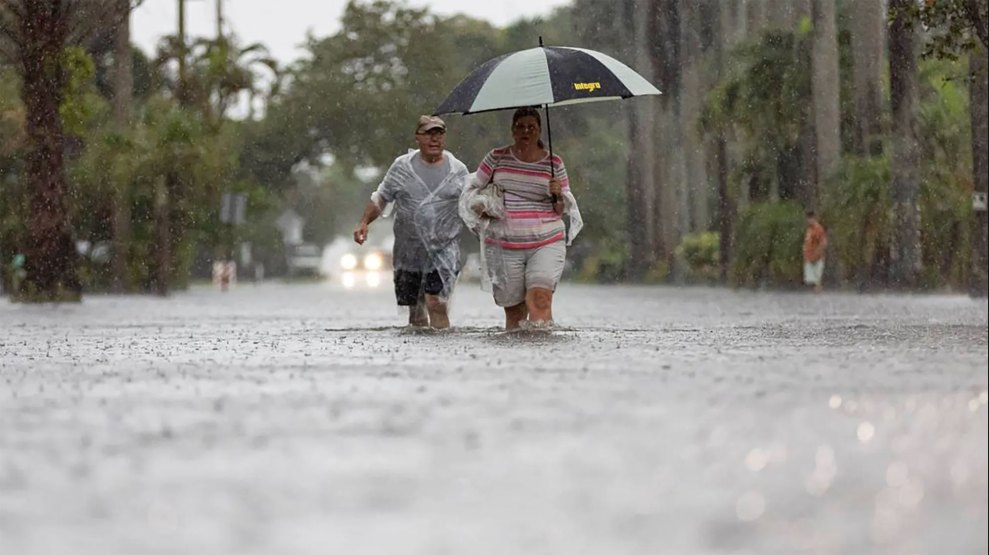
Jim Comunale and Pam Mervos walk in Hollywood, Florida as heavy rain floods their neighborhood.Matias J. Ocner/Miami Herald via ZUMA Press Wire
This story was originally published by the Guardian and is reproduced here as part of the Climate Desk collaboration.
Sea level rise driven by global heating will disrupt the daily life of millions of Americans, as hundreds of homes, schools and government buildings face frequent and repeated flooding by 2050, a new study has found.
Almost 1,100 critical infrastructure assets that sustain coastal communities will be at risk of monthly flooding by 2050, according to the new research by the Union of Concerned Scientists (UCS). The vast majority of the assets—934 of them—face the risk of flood disruption every other week, which could make some coastal neighborhoods unlivable within two to three decades.
Almost 3 million people currently live in the 703 US coastal communities with critical infrastructure at risk of monthly disruptive flooding by 2050, including affordable and subsidized housing, wastewater treatment facilities, toxic industrial sites, power plants, fire stations, schools, kindergartens and hospitals.
The number of critical infrastructure assets at risk of disruptive flooding is expected to nearly double compared to 2020, even when assuming a medium rate of climate-driven sea level rise (rather than the worst case scenario).
California, Florida, Louisiana, Maryland, Massachusetts, and New Jersey have the most critical infrastructure that needs to be made more flood resilient—or be relocated to safer ground.
Within states, the burden of coastal flooding will not be equal: more than half the critical assets facing frequent flooding by 2050 are located in communities already disadvantaged by historic and current structural racism, discrimination and pollution, the UCS analysis found.
Disadvantaged coastal communities with infrastructure at risk of flooding have higher proportions of Black, Latino and Native American residents. Public and affordable housing represents the single most at-risk infrastructure in these communities.
Almost 7.5 million people live in the 1,758 coastal communities with critical infrastructure at risk of frequent and repeated flooding by the turn of the century.
Routine flooding of critical infrastructure could lead to some of the most vulnerable and underserved children being forced to travel further for school and medical appointments, as well as the contamination of local water supplies by the flooding of polluted soil, according to Juan Declet-Barreto, a report author and senior social scientist for climate vulnerability at UCS.
“Failing to prioritize resilience solutions in these communities risks reinforcing the harmful legacy of environmental racism and colonialism in places already grossly underserved and overlooked,” said Declet-Barreto.
The report, Looming Deadlines for Coastal Resilience, comes at a critical juncture for the climate emergency amid spiraling fossil fuel production in countries like the US, UK, Norway, Canada, China, and Brazil—and deadly heat, floods and drought striking communities across the world with increased frequency and intensity. Meanwhile, the devastating consequences of slow-onset climate disasters such as desertification, melting glaciers and sea level rise are also driving rising costs, the loss of homes and livelihoods, as well as forced displacement for communities across the world.
The world’s oceans are rising, and every year seawater reaches farther inland, which poses an ever-increasing threat to homes, businesses and critical infrastructure. By 2030, the number of critical buildings and facilities at risk of routine and repeat flooding along US coastlines is expected to grow by 20 percent compared to 2020 conditions.
In Charleston, South Carolina, more than 20 high-tide floods were recorded in 2023, sending seawater into the streets and submerging low-lying areas. By 2050, at least 23 essential pieces of infrastructure in Charleston are expected to flood at least twice annually, assuming a medium sea level rise scenario. This includes 17 public housing buildings, which would exacerbate the state’s affordable housing crisis.
UCS researchers identified the critical infrastructure along the entire contiguous US, as well as Guam, Puerto Rico and the US Virgin Islands, which face risk of routine flooding, using data including National Oceanic and Atmospheric Administration (NOAA) tide gauges and three sea level rise scenarios developed by a US Interagency Task Force.
Critical infrastructure includes buildings and facilities that provide functions necessary to sustain daily life—or that if flooded, could unleash environmental hazards. The full impact of coastal flooding is likely to be significantly worse, as drinking water facilities, bus and metro stations, and retirement and care facilities for older adults were not included in the UCS study.
The analysis looks at flooding driven solely by sea level rise and tidal heights. Other climate-related drivers including storm surge, and heavy rainfall which can—and do—increase the risk of disruptive flooding were not included in the study.
The risk of coastal flooding is rising every year. The amount of sea level rise by century’s end will ultimately depend on the world’s willingness to curtail or continue releasing heat-trapping greenhouse gas emissions. But without urgent action to reinforce critical infrastructure, the number of schools, apartment blocks, energy facilities and government buildings at risk of disruptive flooding is expected to rise by at least sevenfold by 2100, according to the UCS analysis.
Almost 7.5 million people currently live in the 1,758 coastal communities with critical infrastructure at risk of frequent and repeated flooding by the turn of the century. Assuming a medium-case scenario, around 4,800 buildings and facilities on US coastlines face the threat of disruptive fooding every fortnight by 2100.
“Even if their homes stay dry, disruptive flooding of vital infrastructure could leave people essentially stranded within their communities or enduring intolerable and even unlivable conditions,” said Erika Spanger, a co-author and director of strategic climate analytics at UCS. “There’s a rapidly approaching deadline for many coastal communities that demands urgent attention.”












